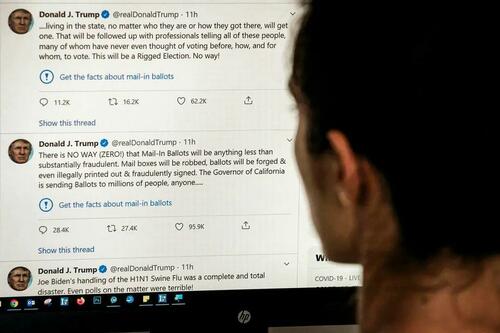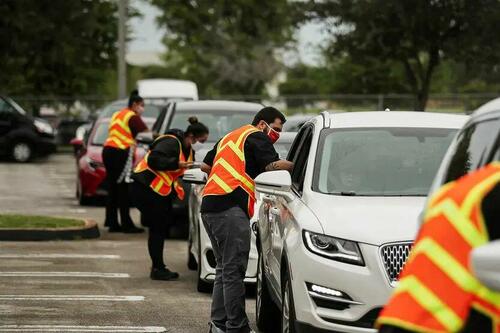by Victor Davis Hanson via American Greatness,
Iranian-backed militias have attacked American installations and forces in Syria, Iraq, and Jordan some 170 times
Ostensibly, these terrorist groups claim they are hitting US forces to coerce America into dropping its support of Israel and demanding a cease-fire in the Gaza war.
In reality, these satellite terrorists are being directed in a larger effort by Iran to pry the US. out of the Middle East, in the manner of the 1983 Marine barracks bombing.
That way, Iran will be free to fulfill its old dream of becoming a nuclear shield for a new Shiite/Persian terrorist axis from Tehran to Damascus to Beirut to the West Bank and Gaza—surrounding Israel and intimidating the Gulf regimes and more moderate states like Jordan and Egypt into concessions.
These Iranian appendages have made a number of unfortunately correct assumptions about America in general and the Biden administration in particular.
One, after the recent serial humiliations of the flight from Afghanistan, the passivity of watching a Chinese spy balloon traverse with impunity the continental United States, the mixed American signals on the eve of the Ukraine war, the troubled Pentagon’s recruitment and leadership lapses, and the destruction of the US southern border, both Iran and its surrogates feel that the United States either cannot or will do much of anything in response to their aggression.
They see the U.S. military short thousands of recruits, its leadership politicized, its munition stocks depleted by arms shipments to Ukraine and Israel, and the massive abandonment of weapons in Kabul.
Two, they view Joe Biden’s serial appeasement as a force multiplier of these perceptions of American weakness. After entering office, the Biden administration begged for a renewed Iran deal from a preening theocracy. It sought to ensure calm by delisting the Houthis from global terrorist designations and sending hundreds of millions of dollars to Hamas and radical Palestinians to buy good behavior.
Biden may have agreed that Iran was the spider in the center of the Middle East Islamic terrorist web, but only thereby to win over it with bribes such as lifting embargoes and sanctions to ensure an Iranian windfall of $90 or more billion in oil sales revenue.
Biden greenlighted a bribery payment of $6 billion to Iran to return American hostages, thereby ensuring more will be taken. It loudly distanced itself from the Netanyahu government. The gulf encouraged radicals to believe they could coerce Israel into accepting radical Islamic states on the West Bank and Gaza.
Three, after hitting American stations and bases 170 times and seeing little sustained, much less disproportionate, responses, Iran and its satellites now feel they are winning proxy wars with the US.
They have all but shut down the Red Sea as an international shipping route—damaging Europe, Egypt, and Israel, which all depend on Red Sea commerce for vital imports and exports.
Iran has forced Biden to publicly alienate the Netanyahu government and push a ceasefire down Israel’s throat. And it has helped to spark international pro-Hamas protests throughout Europe and the US that timid and compliant left-wing governments fear could lose them close elections.
But most damaging are administration spokesmen who mouth the same empty script after each serial attack:
1) The US will respond at the time and place of its own choosing.
2) The US finds no direct evidence of Iranian involvement, although it clearly has supplied the attackers;
3) The US does not wish a wider war and has no plans to attack Iran itself.
Translated to our enemies, it means an 80-year-old non-compos-mentis president is in no position to prevent, much less win, a theater-wide Middle East war that his own serial appeasement has now nearly birthed.
Biden and the Democratic Party know, as National Security Advisor Jake Sullivan pointed out just prior to the October 7 attacks on Israel, that the administration inherited a deterred and quiet Middle East. And then it blew up on their appeasing watch.
Now they are terrified of a theater-wide conflict breaking out during an election year—a fact known to all of America’s Middle East enemies.
Biden and company have forgotten the ancient wisdom that preparing loudly only for peace guarantees war. To prevent war, it should return to oil sanctions on Iran, embargo its banking transactions, slap a travel ban on Iran and its allies, cut off all aid to Hamas and the West Bank, and restore a true terrorist designation for the Houthis.
US officials must stop aimlessly babbling. If the administration must speak, Washington should do so by conveying disproportionality and unpredictability. And if, and when, America were to strike, it should do so in silent and devastating fashion.
When serially attacked, loudly responding that we will only proportionally strike back and wish no wider war will only ensure a big, ugly one.
https://www.zerohedge.com/geopolitical/how-ensure-big-ugly-war-iran-vdh

